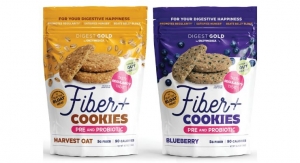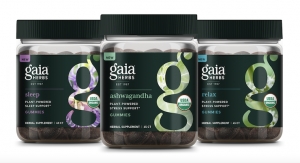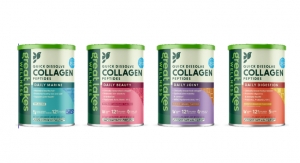Adam Ismail07.01.06
It's no secret that China is fast becoming a global powerhouse, and its impact has certainly been felt in the nutraceuticals industry, especially in ingredient segments where labor is a major component of manufacturing costs. So while the first stage of evolution for China was simply being a net supplier to the global nutraceuticals industry, China is now entering the next phase of its evolution where it will eventually become a net consumer of nutraceuticals.
Underlying this phenomenon are some key macroeconomic trends, which are important to recognize to understand the potential of the Chinese market. For a major economy like China to become a net consumer of high-value products like nutraceuticals, it must have an economy of sufficient size, with adequate spending power to pay for these products.
Today's Chinese economy exceeds $8.2 trillion, compared to the U.S. economy at $12.5 trillion (Economist Intelligence Unit-EIU). This means that China has the power today to produce and consume approximately two-thirds of the goods of the world's largest economy. What is more impressive is that China is growing so much faster than the U.S. that the two nations will essentially be equal in size by 2015 (EIU). The implications of this growth are staggering for nutraceuticals. The nutrition industry in China has grown slightly faster than the Chinese economy every year since at least 1995, and if that trend continues the Chinese nutrition industry will total at least $22.5 billion by 2015 (see Figure 1).
However, China is still developing and much of the population lives in poverty, so growth in disposable income is an important consideration. The population has not had a lot of money to spend in the past, which is why they have essentially only been suppliers to the industry and not consumers. That is changing though. Private expenditures in China are expected to double by 2010 and triple by 2015, according to the EIU. This means that by 2015 the Chinese nutraceuticals industry could grow to just under $25 billion just by maintaining its share of private spending.
Urbanization is a major driver of these trends. In fact, nutraceutical companies should understand that they are not targeting the entire 1.4 billion people living in China when they enter the market. The 30% of the population living in the more heavily populated coastal provinces controls 63% of the entire Chinese economy (National Bureau of Statistics, China). In fact, the majority of the population that do not live in these provinces earn less than $2 per day and don't have the means to buy nutraceuticals. So in actuality, the population that will have the best access to the means needed to buy nutraceuticals is slightly larger than the U.S. population. Also of note, according to the UN Populations Division, by 2025 nearly 55% of the Chinese population will live in these provinces. This could broaden the potential consumer base of nutraceuticals to just under 800 million people and contribute significantly to growth.
If economic growth and urbanization are not enough evidence of the future growth of nutraceuticals, health demographic trends also support these growth forecasts. The aging population is a major underlying growth force in the largest nutraceutical industries in the world (U.S., Japan, Europe). The "One Child" policy in China has created a similar demographic trend; in fact by 2050 there will be twice as many people in China over the age of 50 as there will be under the age of 20. Both urbanization and aging have created a number of health epidemics that nutraceuticals can help address with efficacious products.
Aging populations and urbanization create catalysts for health problems, like stress, more time spent at work, greater wealth, fattier foods, less exercise, etc. China certainly has its share of health problems, and all indications point to them worsening as the years go on. Take hypertension and arthritis, potentially the two largest health crises facing the world's largest country. Hypertension afflicts more than 41% of the population over the age of 35, according to the World Health Organization (WHO). This is also an aging problem, as more than 55% of the population over the age of 50 are hypertensive. Arthritis, the classic aging problem, afflicts over 100 million people in China-that is one-third of all arthritis sufferers in the world! And as the Chinese population gets older, there will be even greater demand because nearly half of all Chinese over the age of 50 already have the condition. The changes in Chinese society have led to a number of other epidemics, including borderline high cholesterol and hyperlipidemia, diabetes, heart disease, lack of fiber and more. Heart disease alone is responsible for 21% of all deaths in China, and this is a largely treatable and preventable condition in which nutraceuticals can play a vital role.
Additionally, prevention is vitally important in China, and perhaps helps de-risk an entry into the country. Burrill & Company estimates that in China the average consumer pays 67% of their healthcare costs because there is limited health insurance. In countries that are developing economically, healthcare expenditures usually increase at a much faster rate than inflation or the economy because the standards of care tend to norm to high Western levels. This is very costly and creates a strong incentive for consumers to avoid hospitalization. The size of the Chinese nutrition industry was estimated by be worth nearly $8 billion in 2004 by Nutrition Business Journal (NBJ), San Diego, CA, and $12.5 billion in 2005 by Frost & Sullivan. These estimates don't marry up perfectly, but it is clear that there is already a significant consumer base buying nutraceuticals for prevention. In fact, the foundations of Traditional Chinese Medicine are all about prevention, so culturally the Chinese have already accepted that you can get health in a tea or from a plant. (See Table 1 next page.)
While all of the macro trends are clearly in place, actually entering the market may be more difficult. Most international companies will need to find the right partner and the right distribution channel, understand the regulatory environment, establish a relationship with the consumer, and in a dynamic country like China, have a strong opinion on what the future holds.
Laws and Regulations: In China, it has been common practice for thousands of years to consume substances (e.g. ingredients, supplements) with putative health benefits. Only in the last decade or so has the Chinese government published laws and regulations in order to standardize industry practices, which historically have been regulated at the regional, not national, level.
The first such national law, the Food Hygiene Law of the People's Republic of China, was adopted on October 30, 1995, and it defined food as "any finished product or raw material (i.e., primary material related to the function of health food) intended for people to eat or drink, as well as any product that has traditionally served as both food and medication, with the exception of products used solely for medical purposes." Such definition provides for the inclusion of both foods and nutrition supplements (known as dietary supplements in the U.S. and food supplements in the EU). This law includes two Articles of particular importance, including Article 22 (If any food is declared to have special effectiveness in healthcare, the product itself and the product description must be submitted to the health department of the State Council for examination and approval. The health department of the State Council shall formulate the hygiene standards and regulations concerning the production and marketing of said product.) and Article 23 (Any food declared to have special effectiveness in healthcare must not be harmful to human health. The contents of the product description must be truthful and the functions and ingredients of the product must conform thereto and must not be fraudulent.), which provide general rules on the definition of, requirements for, as well as examination and approval of health foods, including the active ingredients (i.e., raw materials).
In June 2003, the State Food and Drug Administration (SFDA) took over the responsibility of health food registration approval from the Ministry of Health (MOH). The SFDA's Department of Drug Registration is completely responsible for the approval of health food, including nutrition supplements. In accordance with the Food Hygiene Law of the People's Republic of China and the Administrative Licensing Law of the People's Republic of China, the Interim Administrative Measures for Health Food Registration (Decree No. 19) were promulgated by the SFDA and went into effect on July 1, 2005. With these provisions, the responsibility for the assessment and review of food safety, effectiveness, quality control, and labeling content was assigned formally to SFDA and its subsidiaries.
Health Claims: In contrast to the scientific rigor (i.e., well-substantiated scientific evidence collected according to strict scientific procedures with the results published in peer-reviewed journals) employed by the U.S., Canada and many countries in Europe, Chinese regulations rely more on long established and accepted practice and experience developed in Traditional Chinese Medicine (TCM).
In China, health claims are allowed on health foods provided requirements for public health are met and the claim in question does not em�ploy medical jargon or terms likely to be confused with pharmaceuticals (Article 19 of the Advertisement Law of the People's Republic of China). Wording exaggerating the efficacy of the products may not be used in advertisements and the advice stating, "this product cannot substitute any medicine" must be clearly shown. Since August 1, 2005, no health food advertisements have been allowed to be released in the media prior to examination and approval by food and drug administration departments at the provincial level.
Currently, 27 functional claims have been published and are allowed to be associated with a health food. These include: enhanced immunity; sleep improvement; relief of physical fatigue; enhanced tolerability of oxygen deficiency; help in the protection against the harms caused by radiation; increase in bone density; helps in the protection against chemically induced liver damage; relief of eye fatigue; eliminate acne; eliminate chloasma; improve moisture of skin; improve oil content of skin; weight loss; help in lowering blood glucose, improve growth and development; antioxidation; improve nutritional anemia; help in memory improvement; adjust enteric bacteria colony; promote lead excretion; promote digestion; assists in decreased clearing of the throat; helps in the protection of gastric mucosa; promote lactation; catharsis; helps in lowering blood pressure; and helps in lowering blood lipids.
Each health food product can apply with the SFDA for association with no more than two health functions. If the health food function(s) is/are outside the published scope, the application of registration can still be submitted but the applicant would need to have conducted functional testing (animal, human or both) to support the claim.
Finding the Right Partner: Because language is a barrier for most international companies in China, finding the right partner is critical. China is a trader nation and the number of supplement distributors numbers in the dozens. However, unless a company has strong Chinese marketing and regulatory support in-house, it may make more sense to partner with an actual marketer of nutraceuticals.
The health food side is somewhat fragmented; there were 848 companies in the market in 2002, generating $2.4 billion in sales. What is interesting is that the five largest companies in this sector (Brain Platinum, focus: brain health; Wanji, focus: ginseng foods; Gold Partner, focus: multivitamin foods; Taitai, focus: women's health vitamin foods; and Kangfulai, focus: ginseng foods) accounted for 34% of health food sales, but are very narrowly focused. These companies have an existing distribution system and understand how to market to their consumer bases. In fact, these companies are as good at marketing as any U.S. or European company. However, consumers have lost a little bit of trust in these companies because of a crackdown on aggressive weight loss claims (this sounds a little like Western markets in that regard!).
On the supplement side, Amway is by far the largest company in the market with approximately $470 million in sales in 2003, probably bringing in close to a billion in sales today. The most popular types of supplements in China include calcium, zinc, iron, and multivitamin supplements, led by Centrum, 21 Gold Vita, and Happy Growing. Until recently, 90% of supplements have been sold through pharmacies in China, according to multiple sources. However, direct selling is expected to take a much larger portion of the market with recent regulatory changes. In fact, network marketing companies have been trying to enter the market for years, but only recently has the government issued licenses to market directly to consumers-and even then only within a strict framework.
Regionality is also a driving factor. Each Chinese province is like a separate country with its own culture and language. Consumer approaches to nutraceuticals are very different as well. In provinces with industrial manufacturing bases, consumers tend to be more price and value oriented, but in commercial and financial centers seek out higher quality products. The bottom line, however, is that consumers want nutraceuticals, it is just a matter of how you position a product to align with their varying values.
What is particularly interesting is that consumers have little trust in the claims made by health food companies today, but they do trust supplement manufacturers. It makes sense to assess your product and the capabilities it needs in order to succeed in China. If you need clinical credibility rather than marketing, partnering with a supplement company may make more sense. Alternatively, if your product needs more education, partnering with a direct marketer may be the best option.
All of the foundation elements for growth in nutraceuticals exists in China today: economic development, increasing access to health outlets and products, growing rate of health problems that need treatment options, and incentives for consumers to take preventive action. Because the health food industry is relatively young in China, existing regulations and associated terms remain somewhat ambiguous and may continue to change after a trial period. One of the major challenges in promulgating requirements for health foods (including raw materials) and nutrition supplements is enforcement. Ultimately, entry to the health food market by products of dubious benefit will become more restricted and consumers will be wary of ineffective products. Additionally, advertising for health foods will be better supervised to prevent manufacturers from making false claims about the supposed benefits of their products' functions.NW
About the authors: Adam Ismail is business development manager, Health & Food Technologies, Cargill, Inc., Minneapolis, MN. He can be reached at 952-742-2609; E-mail: adam_ismail@Cargill.com. Harry Rice, PhD, is senior scientist, Regulatory & Scientific Affairs, Cargill, Inc. He can be reached at 952-742-4627; E-mail: harry_rice@cargill.com.
Disclaimer: The opinions expressed in this article are those of the authors and do not represent the opinions or advice from Cargill.
References furnished upon request.
Economics
Underlying this phenomenon are some key macroeconomic trends, which are important to recognize to understand the potential of the Chinese market. For a major economy like China to become a net consumer of high-value products like nutraceuticals, it must have an economy of sufficient size, with adequate spending power to pay for these products.
Today's Chinese economy exceeds $8.2 trillion, compared to the U.S. economy at $12.5 trillion (Economist Intelligence Unit-EIU). This means that China has the power today to produce and consume approximately two-thirds of the goods of the world's largest economy. What is more impressive is that China is growing so much faster than the U.S. that the two nations will essentially be equal in size by 2015 (EIU). The implications of this growth are staggering for nutraceuticals. The nutrition industry in China has grown slightly faster than the Chinese economy every year since at least 1995, and if that trend continues the Chinese nutrition industry will total at least $22.5 billion by 2015 (see Figure 1).
However, China is still developing and much of the population lives in poverty, so growth in disposable income is an important consideration. The population has not had a lot of money to spend in the past, which is why they have essentially only been suppliers to the industry and not consumers. That is changing though. Private expenditures in China are expected to double by 2010 and triple by 2015, according to the EIU. This means that by 2015 the Chinese nutraceuticals industry could grow to just under $25 billion just by maintaining its share of private spending.
Urbanization is a major driver of these trends. In fact, nutraceutical companies should understand that they are not targeting the entire 1.4 billion people living in China when they enter the market. The 30% of the population living in the more heavily populated coastal provinces controls 63% of the entire Chinese economy (National Bureau of Statistics, China). In fact, the majority of the population that do not live in these provinces earn less than $2 per day and don't have the means to buy nutraceuticals. So in actuality, the population that will have the best access to the means needed to buy nutraceuticals is slightly larger than the U.S. population. Also of note, according to the UN Populations Division, by 2025 nearly 55% of the Chinese population will live in these provinces. This could broaden the potential consumer base of nutraceuticals to just under 800 million people and contribute significantly to growth.
Health Conditions
If economic growth and urbanization are not enough evidence of the future growth of nutraceuticals, health demographic trends also support these growth forecasts. The aging population is a major underlying growth force in the largest nutraceutical industries in the world (U.S., Japan, Europe). The "One Child" policy in China has created a similar demographic trend; in fact by 2050 there will be twice as many people in China over the age of 50 as there will be under the age of 20. Both urbanization and aging have created a number of health epidemics that nutraceuticals can help address with efficacious products.
Aging populations and urbanization create catalysts for health problems, like stress, more time spent at work, greater wealth, fattier foods, less exercise, etc. China certainly has its share of health problems, and all indications point to them worsening as the years go on. Take hypertension and arthritis, potentially the two largest health crises facing the world's largest country. Hypertension afflicts more than 41% of the population over the age of 35, according to the World Health Organization (WHO). This is also an aging problem, as more than 55% of the population over the age of 50 are hypertensive. Arthritis, the classic aging problem, afflicts over 100 million people in China-that is one-third of all arthritis sufferers in the world! And as the Chinese population gets older, there will be even greater demand because nearly half of all Chinese over the age of 50 already have the condition. The changes in Chinese society have led to a number of other epidemics, including borderline high cholesterol and hyperlipidemia, diabetes, heart disease, lack of fiber and more. Heart disease alone is responsible for 21% of all deaths in China, and this is a largely treatable and preventable condition in which nutraceuticals can play a vital role.
Prevention
Additionally, prevention is vitally important in China, and perhaps helps de-risk an entry into the country. Burrill & Company estimates that in China the average consumer pays 67% of their healthcare costs because there is limited health insurance. In countries that are developing economically, healthcare expenditures usually increase at a much faster rate than inflation or the economy because the standards of care tend to norm to high Western levels. This is very costly and creates a strong incentive for consumers to avoid hospitalization. The size of the Chinese nutrition industry was estimated by be worth nearly $8 billion in 2004 by Nutrition Business Journal (NBJ), San Diego, CA, and $12.5 billion in 2005 by Frost & Sullivan. These estimates don't marry up perfectly, but it is clear that there is already a significant consumer base buying nutraceuticals for prevention. In fact, the foundations of Traditional Chinese Medicine are all about prevention, so culturally the Chinese have already accepted that you can get health in a tea or from a plant. (See Table 1 next page.)
Entering the Market
While all of the macro trends are clearly in place, actually entering the market may be more difficult. Most international companies will need to find the right partner and the right distribution channel, understand the regulatory environment, establish a relationship with the consumer, and in a dynamic country like China, have a strong opinion on what the future holds.
Laws and Regulations: In China, it has been common practice for thousands of years to consume substances (e.g. ingredients, supplements) with putative health benefits. Only in the last decade or so has the Chinese government published laws and regulations in order to standardize industry practices, which historically have been regulated at the regional, not national, level.
The first such national law, the Food Hygiene Law of the People's Republic of China, was adopted on October 30, 1995, and it defined food as "any finished product or raw material (i.e., primary material related to the function of health food) intended for people to eat or drink, as well as any product that has traditionally served as both food and medication, with the exception of products used solely for medical purposes." Such definition provides for the inclusion of both foods and nutrition supplements (known as dietary supplements in the U.S. and food supplements in the EU). This law includes two Articles of particular importance, including Article 22 (If any food is declared to have special effectiveness in healthcare, the product itself and the product description must be submitted to the health department of the State Council for examination and approval. The health department of the State Council shall formulate the hygiene standards and regulations concerning the production and marketing of said product.) and Article 23 (Any food declared to have special effectiveness in healthcare must not be harmful to human health. The contents of the product description must be truthful and the functions and ingredients of the product must conform thereto and must not be fraudulent.), which provide general rules on the definition of, requirements for, as well as examination and approval of health foods, including the active ingredients (i.e., raw materials).
In June 2003, the State Food and Drug Administration (SFDA) took over the responsibility of health food registration approval from the Ministry of Health (MOH). The SFDA's Department of Drug Registration is completely responsible for the approval of health food, including nutrition supplements. In accordance with the Food Hygiene Law of the People's Republic of China and the Administrative Licensing Law of the People's Republic of China, the Interim Administrative Measures for Health Food Registration (Decree No. 19) were promulgated by the SFDA and went into effect on July 1, 2005. With these provisions, the responsibility for the assessment and review of food safety, effectiveness, quality control, and labeling content was assigned formally to SFDA and its subsidiaries.
Health Claims: In contrast to the scientific rigor (i.e., well-substantiated scientific evidence collected according to strict scientific procedures with the results published in peer-reviewed journals) employed by the U.S., Canada and many countries in Europe, Chinese regulations rely more on long established and accepted practice and experience developed in Traditional Chinese Medicine (TCM).
In China, health claims are allowed on health foods provided requirements for public health are met and the claim in question does not em�ploy medical jargon or terms likely to be confused with pharmaceuticals (Article 19 of the Advertisement Law of the People's Republic of China). Wording exaggerating the efficacy of the products may not be used in advertisements and the advice stating, "this product cannot substitute any medicine" must be clearly shown. Since August 1, 2005, no health food advertisements have been allowed to be released in the media prior to examination and approval by food and drug administration departments at the provincial level.
Currently, 27 functional claims have been published and are allowed to be associated with a health food. These include: enhanced immunity; sleep improvement; relief of physical fatigue; enhanced tolerability of oxygen deficiency; help in the protection against the harms caused by radiation; increase in bone density; helps in the protection against chemically induced liver damage; relief of eye fatigue; eliminate acne; eliminate chloasma; improve moisture of skin; improve oil content of skin; weight loss; help in lowering blood glucose, improve growth and development; antioxidation; improve nutritional anemia; help in memory improvement; adjust enteric bacteria colony; promote lead excretion; promote digestion; assists in decreased clearing of the throat; helps in the protection of gastric mucosa; promote lactation; catharsis; helps in lowering blood pressure; and helps in lowering blood lipids.
Each health food product can apply with the SFDA for association with no more than two health functions. If the health food function(s) is/are outside the published scope, the application of registration can still be submitted but the applicant would need to have conducted functional testing (animal, human or both) to support the claim.
Finding the Right Partner: Because language is a barrier for most international companies in China, finding the right partner is critical. China is a trader nation and the number of supplement distributors numbers in the dozens. However, unless a company has strong Chinese marketing and regulatory support in-house, it may make more sense to partner with an actual marketer of nutraceuticals.
The health food side is somewhat fragmented; there were 848 companies in the market in 2002, generating $2.4 billion in sales. What is interesting is that the five largest companies in this sector (Brain Platinum, focus: brain health; Wanji, focus: ginseng foods; Gold Partner, focus: multivitamin foods; Taitai, focus: women's health vitamin foods; and Kangfulai, focus: ginseng foods) accounted for 34% of health food sales, but are very narrowly focused. These companies have an existing distribution system and understand how to market to their consumer bases. In fact, these companies are as good at marketing as any U.S. or European company. However, consumers have lost a little bit of trust in these companies because of a crackdown on aggressive weight loss claims (this sounds a little like Western markets in that regard!).
On the supplement side, Amway is by far the largest company in the market with approximately $470 million in sales in 2003, probably bringing in close to a billion in sales today. The most popular types of supplements in China include calcium, zinc, iron, and multivitamin supplements, led by Centrum, 21 Gold Vita, and Happy Growing. Until recently, 90% of supplements have been sold through pharmacies in China, according to multiple sources. However, direct selling is expected to take a much larger portion of the market with recent regulatory changes. In fact, network marketing companies have been trying to enter the market for years, but only recently has the government issued licenses to market directly to consumers-and even then only within a strict framework.
Regionality is also a driving factor. Each Chinese province is like a separate country with its own culture and language. Consumer approaches to nutraceuticals are very different as well. In provinces with industrial manufacturing bases, consumers tend to be more price and value oriented, but in commercial and financial centers seek out higher quality products. The bottom line, however, is that consumers want nutraceuticals, it is just a matter of how you position a product to align with their varying values.
What is particularly interesting is that consumers have little trust in the claims made by health food companies today, but they do trust supplement manufacturers. It makes sense to assess your product and the capabilities it needs in order to succeed in China. If you need clinical credibility rather than marketing, partnering with a supplement company may make more sense. Alternatively, if your product needs more education, partnering with a direct marketer may be the best option.
Summary
All of the foundation elements for growth in nutraceuticals exists in China today: economic development, increasing access to health outlets and products, growing rate of health problems that need treatment options, and incentives for consumers to take preventive action. Because the health food industry is relatively young in China, existing regulations and associated terms remain somewhat ambiguous and may continue to change after a trial period. One of the major challenges in promulgating requirements for health foods (including raw materials) and nutrition supplements is enforcement. Ultimately, entry to the health food market by products of dubious benefit will become more restricted and consumers will be wary of ineffective products. Additionally, advertising for health foods will be better supervised to prevent manufacturers from making false claims about the supposed benefits of their products' functions.NW
About the authors: Adam Ismail is business development manager, Health & Food Technologies, Cargill, Inc., Minneapolis, MN. He can be reached at 952-742-2609; E-mail: adam_ismail@Cargill.com. Harry Rice, PhD, is senior scientist, Regulatory & Scientific Affairs, Cargill, Inc. He can be reached at 952-742-4627; E-mail: harry_rice@cargill.com.
Disclaimer: The opinions expressed in this article are those of the authors and do not represent the opinions or advice from Cargill.
References furnished upon request.



























